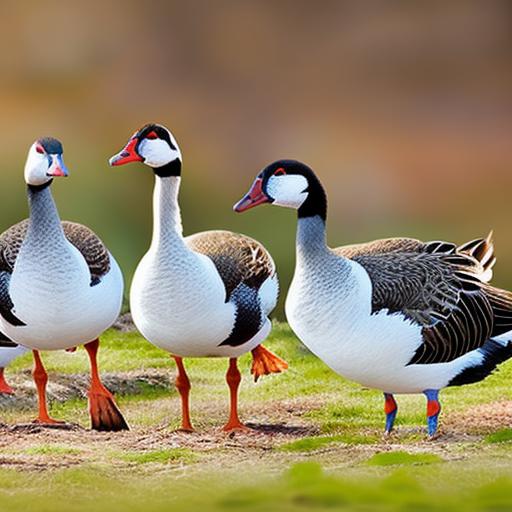Geese are a popular choice for many farmers and homesteaders due to their versatility and usefulness. There are several different breeds of geese, each with its own unique characteristics and traits. Some of the most common goose breeds include the Toulouse, Embden, Chinese, and African. The Toulouse is a large, heavy breed known for its calm and gentle nature, making it a popular choice for meat production. The Embden is another large breed, known for its white plumage and friendly disposition. The Chinese goose is a smaller breed, often used for weed control and as a guard animal. The African goose is a medium-sized breed with a distinctive knob on its forehead and is known for its excellent foraging abilities.
Each breed of goose has its own specific needs and requirements, so it’s important to research and understand the characteristics of each breed before deciding which one is right for you. Factors to consider include size, temperament, and intended use, whether it be for meat, eggs, or as a guard animal. By understanding the different goose breeds, you can make an informed decision and provide the best care for your geese.
Creating a Suitable Living Environment for Multiple Goose Breeds
Creating a suitable living environment for multiple goose breeds is essential for their health and well-being. Geese require a secure and spacious area to roam and forage, as well as access to fresh water for drinking and bathing. When housing multiple goose breeds together, it’s important to provide enough space to accommodate their different needs and behaviors. For example, larger breeds like the Toulouse and Embden may require more space than smaller breeds like the Chinese or African goose.
In addition to space, the housing should also provide protection from predators and the elements. This can be achieved through the use of fencing, predator-proof housing, and adequate shelter. Geese are also known for their messy habits, so it’s important to regularly clean and maintain their living environment to prevent the buildup of waste and bacteria. By creating a suitable living environment for multiple goose breeds, you can ensure their health and happiness.
Feeding and Nutrition for Multiple Goose Breeds
Feeding and nutrition are crucial aspects of caring for multiple goose breeds. Geese are herbivores and require a diet that is high in fiber and low in protein. They should have access to fresh grass, weeds, and other greens, as well as a balanced commercial feed specifically formulated for waterfowl. When feeding multiple goose breeds, it’s important to consider their individual dietary needs and adjust their feeding regimen accordingly. For example, larger breeds may require more food than smaller breeds, and breeding or laying geese may have different nutritional requirements.
In addition to their regular diet, geese also require access to clean, fresh water for drinking and bathing. This is especially important during the breeding season, as geese need to stay hydrated and maintain their plumage for nesting and egg incubation. Providing a balanced and nutritious diet for multiple goose breeds is essential for their overall health and productivity.
Health and Wellness Considerations for Keeping Multiple Goose Breeds
Keeping multiple goose breeds healthy and well requires regular monitoring and preventative care. Geese are generally hardy animals, but they can be susceptible to certain health issues such as respiratory infections, parasites, and foot problems. It’s important to observe your geese regularly for any signs of illness or injury, and to seek veterinary care if necessary. In addition to regular health checks, preventative measures such as vaccination, deworming, and parasite control can help keep your geese in good health.
Another important aspect of maintaining the health and wellness of multiple goose breeds is providing a clean and sanitary living environment. This includes regular cleaning of their housing, providing access to clean water, and practicing good biosecurity measures to prevent the spread of disease. By prioritizing the health and wellness of your geese, you can ensure their longevity and productivity.
Social Dynamics and Behavior of Multiple Goose Breeds
Understanding the social dynamics and behavior of multiple goose breeds is essential for maintaining a harmonious flock. Geese are social animals and form strong bonds with their flock mates, so it’s important to provide a suitable environment that allows for natural social interactions. When keeping multiple goose breeds together, it’s important to consider their individual temperaments and behaviors. For example, some breeds may be more dominant or aggressive, while others may be more docile and submissive.
It’s also important to consider the gender ratio within the flock, as this can impact the social dynamics and behavior of the geese. For example, having too many males in the flock can lead to aggression and fighting, while having too few can result in stress and social isolation. By understanding the social dynamics and behavior of multiple goose breeds, you can create a harmonious and balanced flock.
Breeding and Reproduction of Multiple Goose Breeds
Breeding and reproduction are natural behaviors for geese, and understanding the process is important for those keeping multiple goose breeds. Geese typically reach sexual maturity at around 2 years of age, and breeding usually occurs in the spring and early summer. When keeping multiple goose breeds together, it’s important to consider the potential for interbreeding and the genetic implications of crossbreeding. If you are interested in breeding your geese, it’s important to research the specific breeding requirements and considerations for each breed.
In addition to breeding, it’s important to consider the nesting and incubation needs of multiple goose breeds. Geese are known for their strong nesting instincts and will require a suitable nesting area to lay and incubate their eggs. Providing a safe and secure nesting area, as well as access to suitable nesting materials, is essential for successful breeding and reproduction. By understanding the breeding and reproduction needs of multiple goose breeds, you can support their natural behaviors and ensure the health and vitality of future generations.
Managing Conflicts and Aggression Among Multiple Goose Breeds
Managing conflicts and aggression among multiple goose breeds is an important aspect of maintaining a harmonious flock. Geese can be territorial and aggressive, especially during the breeding season, so it’s important to provide a suitable environment that minimizes potential conflicts. When keeping multiple goose breeds together, it’s important to provide enough space and resources to prevent competition and aggression. This can include providing multiple feeding and watering stations, as well as separate areas for nesting and resting.
It’s also important to observe the behavior of your geese regularly and intervene if necessary to prevent conflicts from escalating. This can include separating aggressive individuals, providing distractions or enrichment, and implementing positive reinforcement training to encourage peaceful interactions. By managing conflicts and aggression among multiple goose breeds, you can create a harmonious and balanced flock.
Training and Handling Multiple Goose Breeds
Training and handling multiple goose breeds is an important aspect of their care and management. Geese can be trained to respond to basic commands, such as coming when called or moving to a specific area. This can be useful for managing their behavior and ensuring their safety, especially in a multi-breed flock. When training and handling multiple goose breeds, it’s important to use positive reinforcement techniques and to be patient and consistent in your approach.
In addition to training, handling your geese regularly can help build trust and social bonds, making it easier to manage and care for them. This can include gentle handling, regular health checks, and providing enrichment and social interaction. By training and handling multiple goose breeds, you can build a strong and positive relationship with your geese, making it easier to manage their behavior and care.
Integrating New Goose Breeds into an Existing Flock
Integrating new goose breeds into an existing flock requires careful planning and consideration. Geese are territorial animals and can be resistant to change, so it’s important to introduce new birds gradually and with care. When introducing new goose breeds, it’s important to provide a separate area for them to acclimate to their new surroundings and to observe the behavior of the existing flock. This can help prevent potential conflicts and aggression as the geese establish their social hierarchy.
It’s also important to consider the gender ratio and age of the new birds, as this can impact their integration into the existing flock. For example, introducing a single new male into a flock of females can lead to aggression and fighting, while introducing a group of young geese may be easier for them to integrate. By carefully planning and managing the integration of new goose breeds, you can minimize potential conflicts and ensure a smooth transition for all birds.
Common Mistakes to Avoid When Keeping Multiple Goose Breeds
Keeping multiple goose breeds can be a rewarding experience, but there are several common mistakes to avoid to ensure the health and well-being of your flock. One common mistake is overcrowding, which can lead to stress, aggression, and the spread of disease. It’s important to provide enough space and resources to accommodate the needs of each breed and to prevent competition and conflict.
Another common mistake is neglecting the social dynamics and behavior of the geese, which can lead to aggression and fighting. It’s important to observe the behavior of your geese regularly and to intervene if necessary to prevent conflicts from escalating. Additionally, neglecting the health and wellness of your geese, including their diet, housing, and preventative care, can lead to a range of health issues and decreased productivity.
In conclusion, keeping multiple goose breeds requires careful planning, consideration, and management to ensure the health and well-being of the flock. By understanding the different breeds, creating a suitable living environment, providing proper nutrition, prioritizing health and wellness, managing social dynamics and behavior, supporting breeding and reproduction, managing conflicts and aggression, training and handling, integrating new breeds, and avoiding common mistakes, you can create a harmonious and balanced flock of geese. With the right care and management, keeping multiple goose breeds can be a rewarding and fulfilling experience for farmers and homesteaders alike.
Meet Walter, the feathered-friend fanatic of Florida! Nestled in the sunshine state, Walter struts through life with his feathered companions, clucking his way to happiness. With a coop that’s fancier than a five-star hotel, he’s the Don Juan of the chicken world. When he’s not teaching his hens to do the cha-cha, you’ll find him in a heated debate with his prized rooster, Sir Clucks-a-Lot. Walter’s poultry passion is no yolk; he’s the sunny-side-up guy you never knew you needed in your flock of friends!







